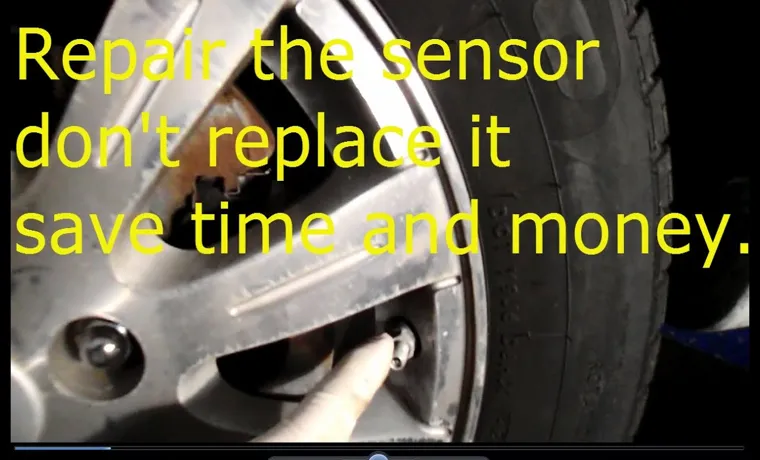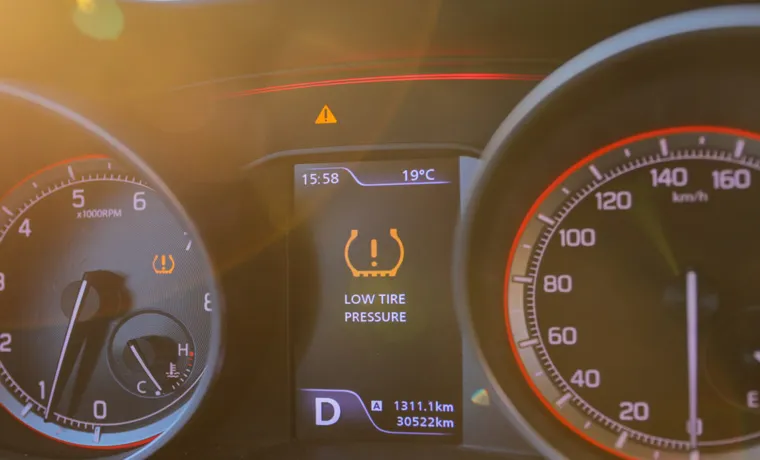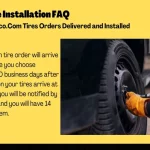Have you ever been driving and suddenly get a notification on your dashboard about a tire sensor issue? It can be frustrating, especially when you don’t know what’s causing it. But don’t worry, fixing a tire sensor is easier than you might think. A tire sensor is a small device attached inside the tire that monitors its pressure and temperature levels.
It communicates with the car’s computer system, letting you know when there’s a problem. If you’re experiencing issues, don’t let it ruin your day. In this blog, we’ll provide you with a step-by-step guide on how to fix a tire sensor and get back on the road in no time.
Let’s dive in!
Table of Contents
Understanding the Problem
If you’re experiencing issues with your tire pressure monitoring system (TPMS) and wondering how to fix a tire sensor, you’re not alone. TPMS sensors are prone to damage and malfunction due to exposure to harsh weather conditions and road hazards. Before attempting to fix a tire sensor, it’s crucial to understand the root of the problem.
The most common issue with TPMS sensors is a low battery level. If the sensor has been in use for more than five to seven years, it’s a high time to replace the battery. Additionally, dirt, debris, and corrosion build-up can interfere with the sensor’s functionality.
In such cases, cleaning the sensors thoroughly or replacing them may be the solution. However, if none of these remedies work, it’s advisable to seek a professional mechanic’s help to diagnose and fix the issue. Remember that a TPMS sensor is a crucial safety system that you don’t want to compromise.
Symptoms of a Faulty Tire Sensor
If you notice that your tire pressure gauge is constantly showing low pressure readings, there’s a good chance that your tire sensor is faulty. A faulty tire sensor can be frustrating, as it can lead to inaccurate readings and even cause an accident if the tire pressure is too low. Some common symptoms of a faulty tire sensor include the Tire Pressure Monitoring System (TPMS) warning light turning on, inconsistent readings, or no readings at all.
It’s important to get your tires checked for damage and ensure the tire sensor is functioning properly to avoid any future mishaps. Don’t hesitate to take your car to a trusted mechanic or tire expert to conduct a professional inspection if you suspect that your tire sensor is at fault. By doing this, you can ensure that you have a safe and enjoyable driving experience on the road.

Why a Faulty Tire Sensor can be Dangerous
A faulty tire sensor can be a dangerous problem that many drivers may not even be aware of. This sensor is responsible for monitoring the air pressure in your tires, ensuring they are properly inflated. When a sensor malfunctions, it can lead to inaccurate readings, making it difficult to determine if your tires are inflated enough or not.
This can lead to a variety of issues, including decreased fuel efficiency, uneven wear on your tires, and even blowouts. It’s imperative to regularly check your tire pressure manually in addition to relying on the sensor to ensure your safety on the road. A simple malfunctioning sensor can lead to costly repairs and potentially dangerous situations, so it’s always better to be cautious and stay on top of your tire maintenance.
How to Fix a Tire Sensor
Tire sensors play an essential role in keeping drivers safe on the road, but sometimes they can malfunction or give incorrect readings. If you’re wondering how to fix a tire sensor, there are a few steps you can take. Firstly, check the tire pressure and make sure it matches the recommended pressure for your vehicle.
If that doesn’t fix the issue, try resetting the sensor by pressing a reset button or having it done manually at a mechanic’s shop. If the sensor still isn’t working, there may be a problem with the sensor or the wiring, and it’s best to have a professional diagnose and repair the issue. Overall, if you pay attention to your vehicle’s tire sensors and take prompt action if they start giving incorrect readings, you’ll be on the road to a safer driving experience.
Start with a Diagnostic Check
If you’re experiencing problems with your tire pressure monitoring system, the first step is to perform a diagnostic check on your sensors. This will help pinpoint the exact sensor or sensors causing the issue. Start by checking the tire pressure on all four tires.
If the pressure is low, fill it to the recommended level and check if the warning light on your dashboard goes away. If it persists, you may have a faulty sensor. One way to test if a sensor is faulty is by using a tire pressure gauge.
Remove each tire and check the pressure manually with a gauge. If the reading matches the recommended pressure, then the sensor is likely the issue. You can either replace the sensor yourself or take it to a professional for repair.
A sensor replacement is a quick and easy fix that will restore your tire pressure monitoring system and keep you safe on the road.
Replacing the Sensor
If you need to fix a tire sensor, one of the most common solutions is to replace the existing one. A tire sensor is an essential component of your vehicle, as it helps you monitor the tire pressure and ensure a safe and smooth ride. The good news is that replacing a tire sensor is a relatively straightforward task that you can do yourself.
First, you’ll need to locate the sensor on the wheel and remove it carefully. Then, you can install a new sensor and tighten it securely using a torque wrench. Don’t forget to reset the sensor by following the instructions provided by the manufacturer or your vehicle’s manual.
With a bit of patience and attention to detail, you can easily fix your tire sensor and avoid potential safety hazards on the road.
Resetting the Sensor
Tire sensor problems can be a real headache. But did you know that you may be able to fix the issue just by resetting the sensor? It’s a simple process that can save you time and money. To begin, locate the reset button or switch on the dashboard of your car.
Press and hold this button for several seconds until the tire pressure warning light blinks twice. This indicates that the sensor has been reset. Now, check the tire pressure of each tire with a gauge to ensure they are all at the correct level.
If the warning light stays on, you may need to take your car to a mechanic to diagnose and fix the issue. Remember, keeping your tire pressure at the correct level is crucial for both your safety and fuel efficiency. So, take care of those tire sensors and stay on top of maintenance to save yourself from headaches down the road.
Preventing Future Problems
If you’ve ever had the displeasure of dealing with a malfunctioning tire sensor, you know how frustrating it can be. Not only does it result in the constant annoyance of a warning light on your dashboard, but it can also compromise your safety on the road. Luckily, fixing a tire sensor is a relatively simple process that you can do yourself.
First, make sure your tires are properly inflated and not damaged in any way. Next, use a quality tire pressure gauge to check the pressure in each tire. If all tires are properly inflated, but the warning light persists, you may need to replace the tire sensor itself.
This involves removing the old sensor and installing a new one in its place. One tip to prevent future problems is to regularly check your tire pressure and keep them properly inflated. This can help extend the lifespan of your tire sensors and prevent any issues from arising in the first place.
Remember, proper maintenance is key to avoiding costly repairs and staying safe on the road.
Regular Tire Maintenance
Regular Tire Maintenance Regular tire maintenance is crucial for ensuring a safe and reliable driving experience. It involves taking care of your tires and ensuring they are in good condition to prevent future issues. One way to do this is by checking the tire pressure regularly and maintaining it at the recommended level.
Proper tire pressure can help improve fuel efficiency, reduce wear and tear, and maximize the tire’s lifespan. Additionally, checking for wear and tear on the treads is essential. Worn-out treads can make it difficult to grip the road, especially in wet conditions, increasing the risk of an accident.
Furthermore, it’s essential to rotate the tires as recommended by the vehicle manufacturer. Rotating your tires can distribute wear evenly, extending their life. By taking care of your tires, you can avoid costly repairs, improve fuel efficiency, and maintain the safety of your vehicle.
So, don’t neglect regular tire maintenance, make it a habit and ensure your tires last longer and keep you safe on the road.
Monitoring the Sensor
When it comes to sensor monitoring, prevention is key. By regularly monitoring the sensor and addressing any potential issues early on, future problems can be avoided. This includes checking for any signs of wear and tear on the sensor itself, as well as ensuring that all connections are secure and functioning properly.
It’s also important to keep an eye on the data output from the sensor, looking for any anomalies or patterns that could indicate a problem. By staying vigilant and proactive with sensor monitoring, you can help ensure that your equipment stays in optimal condition and avoid potentially costly downtime. So, don’t wait until there’s a problem to check your sensor – take preventative measures now to protect your equipment and your bottom line.
Final Thoughts
If you’re experiencing tire sensor issues, don’t worry – there are some simple steps you can take to fix them. First, check the pressure of your tires to make sure they’re properly inflated. If they are, the issue may lie with a faulty sensor.
To fix this, find the sensor on each tire, usually located near the valve stem. Use a tire pressure monitoring system tool to reset the sensor or replace the battery if needed. If you’ve tried these steps and the issue persists, it may be time to visit a professional mechanic to diagnose and repair the issue.
With a little bit of effort, fixing a tire sensor doesn’t have to be a difficult task, and can help ensure your safety on the road.
Conclusion
In conclusion, fixing a tire sensor is not about brute force or technical expertise, but rather a blend of patience, curiosity, and resourcefulness. Much like solving a puzzling mystery, one must carefully assess the evidence, follow the clues, and think creatively to find the solution. So the next time your tire pressure warning light starts blinking, don’t panic or call a mechanic right away.
Instead, channel your inner Sherlock Holmes, grab a tire gauge and a flashlight, and embark on a fascinating tire sensor fixing adventure. Who knows, you might even impress your friends with your newfound skills and earn the title of “tire whisperer.” Happy fixing!”
FAQs
What are the signs that indicate a faulty tire sensor?
The most common signs include a warning light on the dashboard, low tire pressure, and inaccurate tire pressure readings.
Can a tire sensor be replaced or do I need to replace the entire tire?
Most often, the tire sensor can be replaced separately without requiring a new tire. However, it’s best to check with a professional for guidance.
How do I reset my tire sensor after replacing a tire?
To reset the tire sensor, you will need to follow the specific instructions outlined in your vehicle manual, which typically involve driving the car for a certain distance at a certain speed.
Can low tire pressure cause a tire sensor to malfunction?
Yes, low tire pressure is a common cause of tire sensor malfunction. It’s important to regularly check and maintain proper tire pressure.
How often do tire sensors need to be replaced?
Tire sensors typically last anywhere from 5-10 years, depending on usage and proper maintenance. It’s important to check them periodically and replace them as needed.
Can I drive with a malfunctioning tire sensor?
Yes, you can still drive with a malfunctioning tire sensor, but it’s important to have it checked and fixed as soon as possible to avoid potential safety risks.
Can tire sensors be affected by extreme weather conditions?
Yes, extreme weather conditions, such as extreme cold or heat, can affect tire sensor function. It’s important to monitor them closely during these conditions and have them checked if issues arise.



